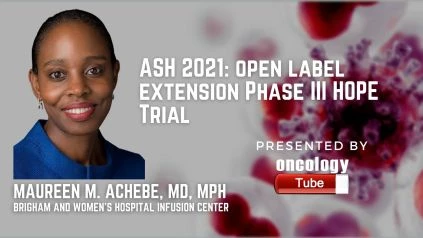Maureen M. Achebe, MD, MPH, Associate Physician, Brigham and Women’s Hospital, Assistant Professor of Medicine, Harvard Medical School, Associate Director, Brigham and Women’s Hospital Infusion Center speaks about the ASH 2021 Abstract – 3114 Long-Term Safety and Efficacy of Voxelotor for Patients with Sickle Cell Disease: Results from an Open-Label Extension of the Phase 3 HOPE Trial.
Link to Abstract:
https://ash.confex.com/ash/2021/webprogram/Paper153582.html
Background:
Sickle cell disease (SCD) is a lifelong inherited blood illness caused by a mutation in the hemoglobin (Hb) subunit gene, which results in the development of sickle hemoglobin (HbS). Hemolysis, chronic anemia, and vaso-occlusive crises are all caused by HbS polymerization, which causes red blood cell sickling and damage (VOCs). As a result of decreased Hb and increased hemolysis, patients with SCD are at a higher risk of end-organ damage, increased morbidity, and early mortality.
The HbS polymerization inhibitor Voxelotor (Oxbryta®) tablets are licensed in the United States for the treatment of SCD in adults and adolescents aged 12 years. In the randomized, placebo-controlled HOPE study, considerably more patients treated with voxelotor 1500 mg than placebo had a >1 g/dL Hb rise at any point up to week 72 (89 percent versus 25 percent, respectively). These increases in hemoglobin were linked to lower levels of hemolysis markers (eg, indirect bilirubin, reticulocyte percentage). We present an interim analysis of an ongoing open-label extension (OLE) of the HOPE experiment to confirm the safety and efficacy of long-term voxelotor usage.
Methods:
Patients who completed the phase 3 HOPE trial were eligible to engage in the multicenter OLE study and receive therapy as long as they continued to benefit clinically and/or until commercialization or a managed access program made voxelotor available to them. Patients who had previously received placebo or voxelotor 900 mg were given voxelotor 1500 mg as a maintenance dose. Data on adverse events were gathered from the time of informed consent to 28 days after voxelotor was stopped. Hb and clinical hemolysis indicators measurements are ongoing in the OLE, and the results are reported here for 48 weeks of treatment. For the United States and Europe, central laboratory assessments were employed, whereas for the rest of the globe, local laboratory assessments were used. The information shown is based on a preliminary data cut (December 31, 2020).
Results:
178 (89.4%) of the 199 participants who completed the HOPE study were enrolled and dosed in the OLE. At the time of enrolment, the median age was 25 years old (15.7 percent adolescents, 84.3 percent adults). The median duration of voxelotor exposure in the OLE was 69.9 weeks (range: 1.9-102.0 weeks) at the cutoff date, with 78 patients treated for a total of 72 weeks. 52 of the 78 patients had already received voxelotor in the randomized portion of the study, for a total of 144 weeks of exposure. The mean (SD) change in Hb from baseline (ie, the start of the OLE) to week 48 among those who had previously received placebo was 1.3 (1.51) g/dL, which was consistent with the HOPE study results. Patients who had previously received voxelotor 900 mg and 1500 mg had mean (SD) Hb decreases of 0.7 (1.48) g/dL and 0.2 (1.15) g/dL, respectively, showing that the effect was durable. In the HOPE experiment, patients who received a placebo improved their hemolysis markers from baseline to week 48 (–39.5 percent indirect bilirubin; –28.6 percent reticulocyte percentage). During the HOPE experiment, patients who received voxelotor had a steady response at week 48 (–2.0 percent and 1.1 percent indirect bilirubin, respectively, and –14.6 percent and –21.0 percent reticulocytes for voxelotor 900 mg and 1500 mg). Across all patients, the annualized incidence rate of VOCs was 1.3 (95 percent CI: 1.1-1.4) occurrences per year. A total of 83.7 percent of patients (149/178) had a non-SCD-related treatment-emergent adverse event (TEAE), with arthralgia, headache, pain, nausea, and pain in extremities being the most commonly reported (Table). The severity of most non-SCD-related TEAEs was grade 1 or 2. An adverse event occurred in 11 patients (6.2%), resulting in treatment termination. There were no TEAEs that indicated a lack of tissue oxygenation.
Conclusions:
Treatment with voxelotor 1500 mg resulted in improvements in Hb and clinical indices of hemolysis in patients who received a placebo in the HOPE trial at 48 weeks in this OLE study. In the HOPE experiment, treatment with voxelotor 1500 mg resulted in the maintenance of response in patients who had previously been treated with voxelotor at any dose. The OLE’s safety profile was similar to the results of the HOPE study, and no new safety signals were discovered after a total of 144 weeks of treatment. Long-term use of voxelotor in patients with SCD is safe, well-tolerated, and effective in lowering anemia and hemolysis, with a low rate of VOCs, according to these findings.

